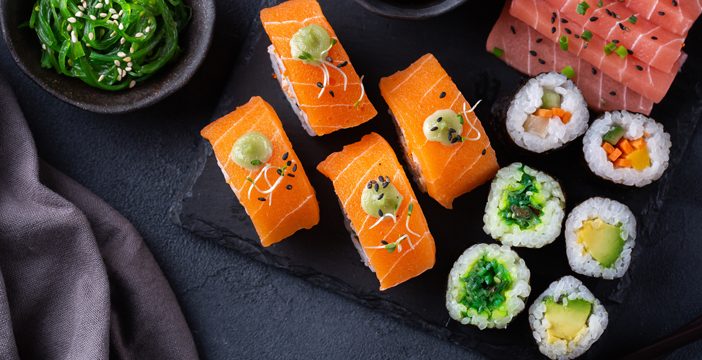
Oh sushi, that delicious combination of fresh seafood, vegetables—and carb-heavy rice! But don’t let the carbs deter you from enjoying sushi when you have diabetes. After all sushi has some major health benefits too. Let’s find out how you can still get your sushi fix even with a diabetes diet.
What types of sushi are there?
Not all sushi is created equal. First introduced in China before making its way to Japan and elsewhere, sushi is traditionally made from small pieces of raw fish that are wrapped in rice and a dried seaweed called nori. They are accompanied by garnishes such as pickled ginger, wasabi and soy sauce. But sushi can also be prepared in other ways with various ingredients. Here’s a list of sushi types and how they’re made:
- Chirashi: Vinegared rice is placed in a bowl and topped with raw fish and nori slices.
- Maki:Fish, vinegared rice and vegetables are rolled in nori and sliced into rounds.
- Nigiri:Vinegared rice is pressed into a mound and then topped with a slice of raw fish.
- Sashimi:Raw fish, thinly sliced, is served on its own.
- Temaki:Fish, vinegared rice, and vegetables are hand-rolled in nori and shaped into a cone.
- Uramaki: Sometimes referred to as an inside-out roll, the vinegared rice is on the outside, and the nori is hidden inside.
Sushi has evolved over time to adapt to North American palates so it can also include fried vegetables and seafood (called tempura) as well as cream cheese and mayonnaise—along with other sauces.
Are there health benefits in eating sushi?
The good news is that fish and shellfish are the star ingredients in sushi, and these are packed with healthy omega-3 fatty acids. The accompanying vegetables are also good sources of nutrients (e.g., fibre, vitamins, potassium etc.) and the nori contains iron, calcium and vitamin A. Some sushi garnishes such as wasabi also have anti-inflammatory properties. Sushi can be low in calories too, making it a good choice when trying to lose or keep weight in check.
The bad news? Raw fish can be a source of bacteria, parasites or viruses. That’s why it’s recommended that pregnant women, children, older adults, and those with a weakened immune avoid sushi or stick to options made with only vegetables or cooked fish.
White rice—another key ingredient in many types of sushi—has also been linked to an increased risk for type 2 diabetes when consumed in large quantities. That’s because white rice has a very high glycemic index, which means it can spike your blood sugar levels.
A final caution is around sushi iterations (i.e., those with added sauces and deep-fried ingredients), which are less nutritious and more caloric.
How can I make sushi more diabetes-friendly?
With diabetes, it’s best to choose sushi made with simple ingredients and minimal additives to reap the health benefits. Some good options include salmon/tuna or vegetarian rolls, sashimi or maki. Steer clear of fried elements (e.g., tempura) and extra sauces that are often high in fat, sugar, sodium and calories. Opt for low-sodium soy sauce if maintaining blood pressure control is an issue for you.
Condiments and garnishes that accompany sushi can be problematic too, so use them sparingly, or avoid altogether.
To help curb blood sugar spikes, start your meal with a bowl of miso soup, salad or side of vegetables—and order brown rice over white because it’s higher in fibre. Don’t hesitate to ask your server about serving sizes and ingredients so you make the best choices for you.
Another option is to make your own sushi at home with a basic sushi-making kit where you can control serving sizes and ingredients. Here’s a tasty recipe for homemade brown rice sushi bowls with crispy salmon.
What can I do to make eating sushi safer?
Given that raw fish can easily spoil, be sure to choose sushi from reputable, busy eateries where there is a high customer turnover rate. Refrigerate raw fish sushi in an airtight container for up to two days and cooked sushi for no more than four days.
If you are making your own sushi, be sure to properly store fish to avoid contamination or stick to vegetarian versions only. Seafood for sashimi should be purchased frozen, which immediately begins killing potential parasites and bacteria.
The bottom line: with a few small tweaks, you can still enjoy sushi in your diabetes diet. With its combination of lean proteins, good fats and vitamin-rich vegetables, sushi can be a nutritious meal option on occasion. As with most foods and diabetes, however, be sure to watch portion sizes and avoid options with deep-fried ingredients and sauces that are heavy in sugar and salt.
If you’re craving some sushi soon, give this pressed quinoa salmon sushi recipe a try.


